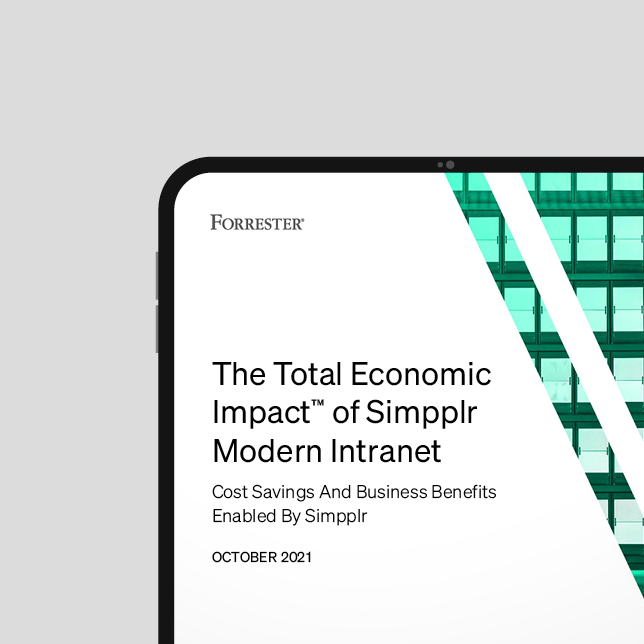Tightening budgets mean it’s more important than ever for internal comms, IT and other intranet stakeholders to measure intranet ROI. Proving a strong return on investment will help convince budget-holders to devote the resources needed to keep your intranet in tip-top shape — or replace it with a stronger solution.
You understand that your intranet is an invaluable tool in the digital workplace — helping your organization centralize and streamline business processes, communication and collaboration. By quantifying the hard and soft returns, you can prove that value to the people who hold the purse strings.
Hard returns are the tangible benefits of an intranet like cutting expenses, time savings, increasing revenue, and lowering turnover. Measuring these benefits helps decision-makers assess the ROI of an intranet investment.
Soft returns are equally important — although harder to measure. Soft returns are intangible benefits like improved employee satisfaction, better collaboration, knowledge sharing, and a more efficient remote work environment.
In this guide to intranet ROI, we look at the hard and soft returns of an intranet investment and some techniques to help you measure those values.
- 1 What are hard returns in intranet investments?
- 2 Measuring hard returns
- 3 What are soft returns in intranet investments?
- 4 Measuring soft returns
- 5 Why to consider both hard and soft returns when measuring intranet ROI
- 6 Intranet ROI case study: Nutanix
- 7 Realize stronger intranet ROI with Simpplr
Let’s get started!
What are hard returns in intranet investments?
Hard returns are the direct and measurable impact that investing in an intranet can have on your business’s profitability. These benefits are often tied to cost savings, revenue growth and increased efficiencies.
Intranet ROI: Cost savings
One of the most obvious hard returns of an intranet investment is the direct cost savings. Instead of paying multiple fees and subscriptions for various business tools — like employee recognition and listening software, help desks, video platforms, calendars, document sharing, etc. — a modern intranet consolidates many such features into one tool and one expense.
Plus, many of these legacy tools and processes are outdated and require manual upkeep and support — amounting to more costs and wasted resources. A 2021 study by Forrester on the Economic Impact of Simpplr’s Intranet found that businesses were able to save an estimated $300,000 over three years on legacy tools by integrating with Simpplr’s intranet.
Intranet ROI: Time savings
Modern intranets are designed to streamline data and collaboration, which inherently saves time. Instead of searching for information or managing tasks through external channels, an effective intranet centralizes all of these activities into a user-friendly interface. The same Forrester study above found that each employee leveraging Simpplr saved an average of 11.2 hours — that’s a tangible boost to employee productivity.
Intranet ROI: Increased sales
The right intranet can improve the sales process and provide employees with the resources they need to better understand their organization’s sales strategy, goals and execution plan. A 2022 report by McKinsey on Creating Value Through Transforming Customer Journeys found that the customer experience (CX) and the employee experience (EX) are closely aligned — and by investing in EX you can indirectly improve the customer journey, increasing sales.
In fact, McKinsey indicated that companies with the best employee and customer experiences achieve revenue growth at a rate 1.8x their competitors.
Intranet ROI: Lower turnover
Retaining top talent is a challenge for most businesses, with high turnover leading to additional recruitment costs and decreased productivity, and hurting employee morale. A well-implemented intranet can help improve employee retention by fostering employee engagement, building up the positive cultural vibe, and empowering leaders to be the best possible managers they can be.
Download this free ebook to discover actionable insights for leveraging your intranet to turn your organization into a talent magnet

Measuring hard returns
Understanding hard returns is important, but measuring the ROI of an intranet investment is how you justify it. Measuring hard returns is how you quantify the benefits we mentioned above.
Whether it’s consolidating expenses, saving wasting resources, improving employee retention, or growing sales — it helps to know what metrics are most helpful in measuring those returns.
Here are a few ways to measure hard returns in intranet investments.
Cost savings metrics
Cost reduction analysis: A cost reduction analysis is a straightforward technique to measure the hard return of your intranet investment in the most literal sense. Systematically identify and analyze your costs before and after implementing the intranet to determine its cost savings.
Telecommuting savings: One of the major benefits of an intranet is its ability to facilitate remote work — thus, reducing the need for office space or energy consumption. Consider measuring the direct savings your business can recognize through more flexible work programs.
Time savings metrics
Average time of support tickets: Measuring the average time it takes to resolve a support ticket can offer insight into your intranet investment.
An effective intranet can cut down on support tickets and free up your IT team’s time to solve other issues faster.
You can measure these benefits by comparing the average time it took your IT team to resolve tickets before and after you implemented a modern intranet. If you’re looking to justify investment in a stronger intranet, measure the average time it takes IT to resolve a support ticket against the time savings reported by organizations who leverage their intranet to provide clear and easily discoverable answers to employee questions.
Average onboarding time: Intranets can help simplify and streamline the employee onboarding process by centralizing resources and information for new employees. Businesses can measure this hard return by tracking the average onboarding time before and after the intranet implementation.
Learn how a modern intranet helps break the IT dependency cycle
Revenue metrics
Sales growth: Intranets can improve the efficiency of your sales team leading to more — and faster — sales. Not only can you shorten the sales cycle, but you can measure the revenue before and after implementing an intranet to show its ROI.
Customer retention metrics: Well-implemented intranets can improve customer service by connecting and supporting frontline employees, and giving them quick and easy access to information they need to both understand and support customers — all of which can improve customer retention. Compare the customer retention rate (CRR) before and after setting up an intranet to measure the hard return.
Turnover metric
Employee retention rate: Research by the Bureau of Labor Statistics shows that the average employee turnover rate in the United States is reaching 13%. Even more alarming, a Deloitte study revealed that millennials’ turnover rate is even higher, at 21%. And the average cost of replacing an employee is 1.5 to 2 times their annual salary, according to the Society for Human Resource Management (SHRM).
Modern intranets are designed to enhance the employee experience, which can lower turnover and increase retention.
Measuring employee retention before and after you launched your intranet can shed light on how valuable an intranet investment is to keeping top talent.
All in all, these intranet ROI measurements provide tangible ways to demonstrate the hard return of intranet investments. By tracking these metrics before and after implementing an intranet — or comparing your current intranet’s performance to the total economic impact of other intranet solutions — you can measure current (or projected) ROI.
What are soft returns in intranet investments?
Soft returns from an intranet investment are the indirect and qualitative impacts that drive organizational growth. These benefits are often harder to measure, but provide value in areas like employee engagement and satisfaction, collaboration and communication.
Here are some of the main soft returns you can expect from an intranet investment:
Employee engagement and satisfaction: An effective intranet has many features designed to enhance employee engagement and satisfaction. It simplifies daily tasks, improves internal communication, streamlines training, and empowers employees and their leaders. And, according to Gallup’s State of the American Workplace report, organizations with a high level of engagement report 21% higher profitability. What’s more, teams that score in the top 20% in engagement realize a 41% reduction in absenteeism and 59% less turnover — a clear indication of stronger employee satisfaction.
Improved collaboration: The positive connection, communication and community that modern intranets enable fosters collaboration. Intranets facilitate collaboration among team members by providing a centralized interface for information, brainstorming, communication and document sharing.
And when employees are empowered to work together harmoniously, organizations realize increased productivity and gains toward shared goals.
Knowledge sharing: An intranet serves as a repository of knowledge within your organization, making it easy for your employees to share insight, best practices and lessons learned. This educational environment helps everyone solve problems faster and fosters employee growth. A study by McKinsey estimates that organizations managing knowledge can see an increase of 25% in productivity.
Digital workplace enablement: Post-pandemic, many organizations have leaned on intranets to manage a remote work environment. Serving as a centralized hub for resources, communication and collaboration, an intranet can enable remote work to be as, if not more, effective than traditional office work. A more flexible work environment can lead to happier, more productive employees — benefiting the organization overall.

Measuring soft returns
Understanding the potential soft returns of an intranet investment is important, but you’ll need to learn how to quantify these qualitative benefits to show the ROI. Measuring the benefits of improved employee satisfaction, better collaboration, knowledge sharing, and digital workplace work enablement is not easy — but it’ll help you justify your investment.
Here are some ways to measure soft returns in intranet investments.
Intranet ROI: Employee satisfaction metrics
Employee engagement surveys: Surveys are a great way to measure qualitative factors like employee engagement. Consider tracking responses of employee surveys before and after implementing your current intranet to assess the sentiment and pulse of your team.
Net Promoter Score (NPS): The Net Promoter Score (NPS) is a valuable metric in measuring intranet ROI because it provides insights into customer satisfaction and loyalty. Intranets are meant to improve customer service, so you should expect a higher NPS following the implementation of an intranet. In fact, according to Deloitte’s Global Human Capital Trends report, organizations with a positive employee experience benefit from twice the customer satisfaction (Net Promoter Score).
Intranet ROI: Collaboration metric
Project completion time: Collaboration is one of the main benefits of an effective intranet, and measuring the time it takes to complete projects is a great indicator of improved collaboration. If projects are being completed faster after implementing an intranet, it suggests a more collaborative environment.
Intranet ROI: Knowledge sharing metrics
Knowledge base usage: Intranets store useful information for employees — often through a database of resources. Measuring employee usage and time spent in the knowledge base can signal a successful intranet implementation.
Number of support tickets: As noted above, sharing information within an intranet enables employees to find answers to questions on their own — which limits the number of support tickets sent to your IT team. Comparing the number of support tickets before and after launching an intranet can help you measure the value of an intranet investment.
Intranet ROI: Digital workplace metrics
Employee productivity: Measuring productivity before and after intranet implementation can be especially important for quantifying the value of digital workplace enablement. If your team is working remotely with similar or better production, this likely is, in part, a result of an effective intranet.
Employee surveys: Surveys can be a valuable tool to measure the effectiveness of your intranet. From accessibility of resources to communication and collaboration, if your intranet is supporting remote work well, your surveys will let you know.
The measurements above help demonstrate the soft returns of intranet investments. By tracking these metrics before and after implementing an intranet — or comparing your current intranet’s performance to the total economic impact of other intranet solutions — you can quantify the qualitative benefits and measure current (or projected) intranet ROI.
Why to consider both hard and soft returns when measuring intranet ROI
Considering both hard and soft returns when measuring intranet ROI is important because business value is not universal and likely amounts to a mix of tangible and intangible benefits.
Measuring the hard returns of an intranet investment will help justify its cost in the most literal sense because you are looking at its direct impact on revenue. If your employees are spending less time looking for answers because of the accessibility of information in your intranet’s knowledge base, the time saved is a tangible (hard) return on that investment.
Tracking hard returns is important, but you should also consider soft returns when measuring intranet ROI.
Soft returns focus on broader benefits to the workplace that improve the employee experience and increase productivity. If your team is able to collaborate better within an intranet, they will be more efficient and connected with their work — leading to improved satisfaction and better results. The indirect benefits of a more collaborative work environment are the soft returns of an intranet investment.
Considering both hard and soft returns paints a complete picture of your intranet’s value. It helps you look beyond the bottom line of that investment and considers the long-term, intangible value. This comprehensive approach offers perspective and helps you accurately assess intranet ROI.
Intranet ROI case study: Nutanix

Founded in 2009, Nutanix experienced immediate success and eventually grew to more than 5,000 employees by 2018. As it scaled, Nutanix began experiencing growing pains with its workforce. Employees struggled to access important information across channels like knowledge bases, wikis and Google Drive — wasting time and often leading to inaccurate or inconsistent information.
Nutanix’s investment in its intranet, powered by Simpplr, yielded both hard and soft returns. An example of a hard return on its intranet investment was a 50% increase in the efficiency of new-hire onboarding. An improved acclimation process for new hires with Simpplr made it easier to scale and directly improved the bottom line.
“When testing the platform, we found a 50% increase in efficiency when individuals searched for onboarding materials,” said CIO Wendy M. Pfeifer. “Such time savings can quickly add up across our entire team and, I believe, will make the difference between just surviving, or thriving during challenging times.”
On the soft returns side, Nutanix noticed a shift in the mindset of its employees post-intranet. Simpplr’s user-friendly interface made it easy for employees to find information, mitigating friction in completing tasks. This improvement in employees’ day-to-day raised the Net Promoter Score (NPS) by an average of 590%.
Ultimately, Nutanix recognized hard and soft returns on its investment in Simpplr. It enhanced employee engagement and satisfaction while directly improving productivity and onboarding.
Download the Nutanix case study to learn more
Realize stronger intranet ROI with Simpplr
Evaluating the return on any business decision is important — and an intranet investment is no different. Investing in an intranet will bring a variety of new features and benefits to your organization. From tangible returns like consolidating expenses and increasing sales to intangible returns like improved collaboration and knowledge sharing, it’s important for you to understand and measure the full intranet ROI.
With Simpplr, you can significantly speed up your return on investment. Integrated work management tools enable efficient team collaboration and improved productivity. And by optimizing your workflows and processes, Simpplr reduces operational costs and helps you achieve your financial goals faster. Request a demo today to learn more!

















